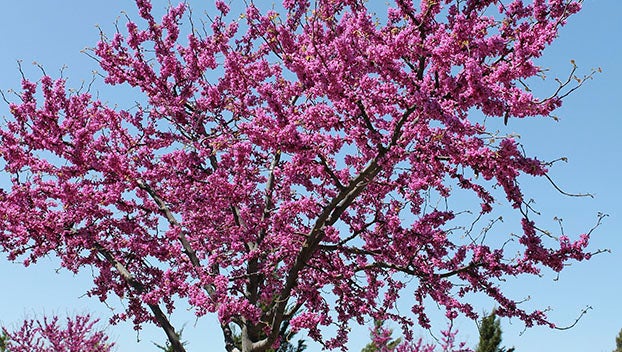The Garden Muse: The eastern redbud
Published 5:00 pm Friday, April 14, 2023
|
Getting your Trinity Audio player ready...
|
 Anyone would be hard pressed to not have taken notice of the beautiful splotches of bright pink dotting the countryside this time of year. If you did not know and have wondered what plant or tree is providing this gorgeous spring display of color along roadsides, in the perimeter understory of wooded lots and occasionally in landscaped yards, it is the Eastern Redbud.
Anyone would be hard pressed to not have taken notice of the beautiful splotches of bright pink dotting the countryside this time of year. If you did not know and have wondered what plant or tree is providing this gorgeous spring display of color along roadsides, in the perimeter understory of wooded lots and occasionally in landscaped yards, it is the Eastern Redbud.
The Cercis canadensis or more commonly known as the Eastern Redbud is a large deciduous shrub or small tree that is native to eastern North America. It is common for native redbuds to have a small- twisted trunk with multiple spreading branches. It can grow to a height of 20 to 30 feet and can spread up to 33 feet.
In the wild, the Redbud mostly grows as an understory tree in mixed growth wooded lots. Cultivars can be grown in open parks and gardens. Please do not try to dig up and relocate native redbuds to a different location. They have a very deep tap root, making the task difficult and most attempts will result in failure and the death of the tree. You will have a much better specimen for your yard or garden if a reliable cultivar is purchased from a nursery.
The bright pink blooms of the Redbud can be found at the axils of the leaves, along the branches and sometimes on the trunk in early spring. The flowers are edible and high in vitamin C. They are reported to have a sweet & tart taste. It is sometimes known as the Spicewood tree, due to its green twigs being used as a seasoning for wild game in some parts of southern Appalachia.
Despite being known as an understory tree, cultivated Redbuds can be grown in full sun or part shade. To achieve the most blooms, plant in full sun. They are relatively tolerant of any soil type if they are planted in moist, but not wet soil medium. Once established, they are drought tolerant. Pruning is generally not required and if needed should be done immediately after blooming, if pruned in winter bud loss most likely will occur.
It is said that George Washington was so enamored with this tree that he had some transplanted from the woods to his gardens at Mount Vernon. I wonder if the descendants to those trees are still there today. But don’t be like George. Leave the native trees in the woods and support your local nursery if you would like one of these beautiful trees in your garden.
Dawn Conrad is a Retired Virginia Cooperative Extension Master Gardener, Herbalist, Writer and Artist. She can be contacted at dawn@mygardenmuse.com.





